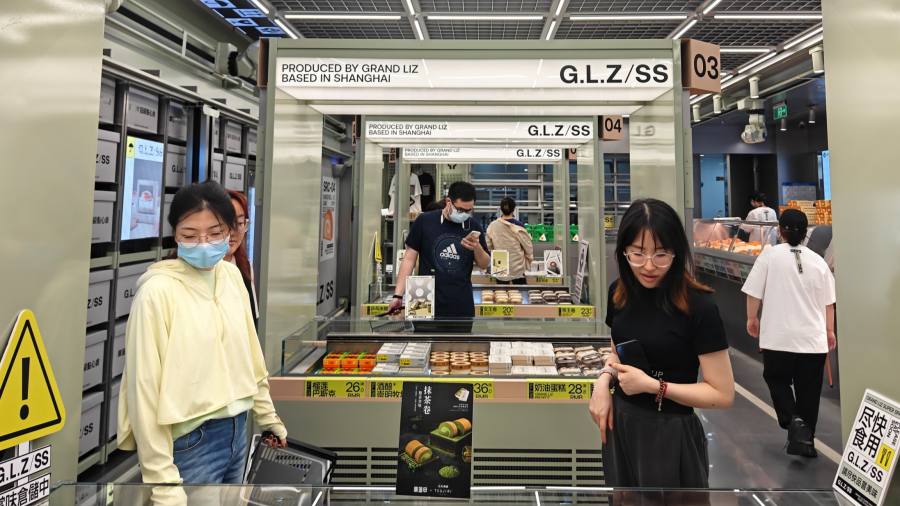Receive free Equities updates
We’ll send you a myFT Daily Digest email rounding up the latest Equities news every morning.
As Chinese stocks rocketed higher in January after stringent Covid restrictions were lifted, strategists at Goldman Sachs made the case that a 46 per cent rise in a matter of weeks was only the beginning.
“China looks well positioned across the growth, policy and inflation cycles in a global context in 2023,” they argued, noting shares could jump another 15 or even 20 per cent if the country managed to fully put disruptive lockdowns behind it. And in the weeks that followed, the MSCI China index rose almost 10 per cent.
But despite optimistic predictions from many of Wall Street’s biggest banks, the market was already nearing the top.
Chinese stocks have fallen more than 20 per cent from their peak in late January — pushing the world’s second-largest economy into a bear market at a time when global and regional peers have outstripped downbeat predictions.
“Did we think China was going to be this bad? No, we were all euphoric about reopening,” said a Hong Kong-based trader at one investment bank. “Just try talking to anyone about Chinese equities right now — it’s like pushing bricks uphill.”
Investors’ high hopes for Chinese stocks rested on three factors. First, tensions with the US would finally subside as regular diplomatic exchanges between Washington and Beijing resumed.
Secondly, strategists expected Chinese consumer spending would roar back as households were finally freed up to spend all the pent-up cash they had been hoarding during lockdowns.
And finally, if that failed, Beijing would step in with large-scale stimulus as it has done so many times before.
But the US government’s outing and downing of a Chinese spy balloon in February derailed a nascent detente and spooked global investors already on alert for financial fallout from rising tensions between the world’s two largest economies.
And instead of deploying excess savings in waves of “revenge spending”, Chinese consumers — scarred by years of economic disruption and financial precarity due to harsh zero-Covid policies — have remained reluctant to make major purchases that could rev up economic growth.
More Chinese consumers preferred to save their earnings in the first six months of 2022, according to findings from a quarterly survey by People’s Bank of China released on Thursday. Almost 60 per cent of respondents said they were more inclined to save their earnings, while just a quarter were more likely to spend them.
“Chinese households appear to be in deleveraging mode, by saving more while paying off loans early,” said Dexter Hsu, a senior analyst with Macquarie. “As [deposits] interest rates continue to decline, households are hunting for yields.”
That has left strategists reliant on the final pillar — Chinese authorities’ tried and trusted policy of spending vast amounts of money trying to stimulate the economy.
“There’s a lot of high expectations of a stimulus package,” said Steven Sun, head of research and equity strategy at HSBC Qianhai Securities. “And suffice to say [authorities] still have a lot of policy room.”
Historically policymakers have focused on real estate development and infrastructure projects, which have long been central to the country’s historically breakneck growth.
But after years of cracking down on excess leverage at Chinese property groups, Beijing is wary of the kind of large-scale stimulus that could cause developers’ debt loads to balloon again. As a result, China has cut rates enough to help stave off a downturn but remains reluctant to deliver the wider support to help turn things around in the way investors anticipated at the start of 2023.
“The economic recovery fell short of expectations as people underestimated the negative feedback loop of the property sector meltdown, underestimated the lack of confidence due to the deteriorating external geopolitical environment and overestimated the rebound from post-pandemic revenge spending,” said Lu Ting, chief China economist at Nomura.
Yet the grim picture painted by recent economic data out of China has convinced some strategists that at least some form of stimulus is likely — and could help turn market sentiment around.
HSBC Qianhai recently trimmed its year-end target for the CSI 300 index of Shanghai- and Shenzhen-listed stocks. Sun described the move as “a tweak” and still expects the benchmark, currently down roughly 1 per cent year to date, to finish 2023 up more than 11 per cent.
Sun said China would rapidly increase its stimulus measures in the second half of the year to help compensate in part for a lack of consumer confidence, though he added policymakers were unlikely to focus on property or infrastructure as they had with previous efforts.
David Chao, global market strategist for Asia Pacific ex-Japan at Invesco, said investors would be tempted to return to Chinese equities because “current valuations are way too bearish”.
He added that more stimulus measures from Beijing were likely in the coming months and could provide a “meaningful boost” to the economy as well as a “signal to markets”, though he added these would “come out in bits and pieces”.
Even Goldman Sachs remains hopeful that a stimulus-backed rebound is still on the cards, explaining in a recent note that policy easing is a “central premise of our constructive market view” and forecasting that China’s onshore stock market will rise 7 per cent from its current level over the next 12 months.
Others are less sanguine. Nomura’s Lu and other sceptical analysts argue that massive monetary stimulus or aggressive interest rate cuts cannot unleash the kind of economic growth needed to restore confidence in the market. That makes the bullish forecasts for Chinese equities unrealistic, they say.
“The market is begging for stimulus,” said Hong Hao, chief economist at Grow Investment Group. “But monetary easing can’t solve the secular problems. The more we feed property, the harder it is to get out of its trap.”
Read the full article here



